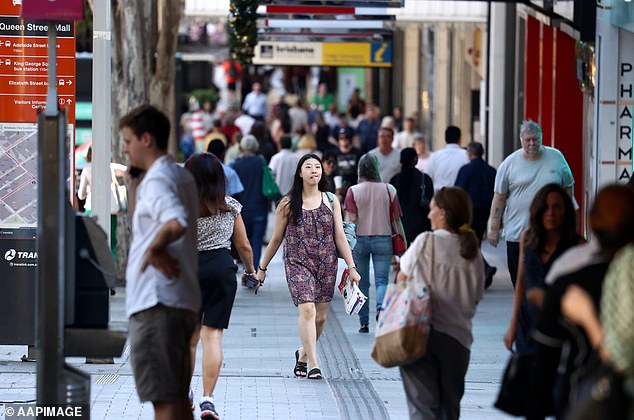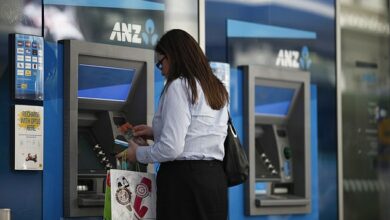RBA governor deals another blow to millions of Australians with mortgages – here’s why you shouldn’t expect rate cuts anytime soon

The Reserve Bank has dealt a further blow to millions of Australians with mortgages by refusing to cut interest rates amid a cost-of-living crisis and blaming high immigration for persistent inflation.
The cash rate remained unchanged at a 12-year high of 4.35 percent, even though the US, UK, Canada, European Union and New Zealand have already cut interest rates this year.
Reserve Bank Governor Michele Bullock on Tuesday delivered a clear message to borrowers hoping for some relief after the most aggressive rate hikes in a generation.
‘Headline inflation will continue to decline for the time being, but underlying inflation is more an indication of inflation dynamics and remains too high,’ she said.
She also blamed international students and high immigration rates in Australia for the cost of living crisis, saying these were the reasons for the growing demand for goods and services.
“Previous declines in real disposable income and the ongoing impact of restrictive financial conditions continue to weigh on consumption, particularly discretionary consumption,” Bullock said.
‘However, growth in overall consumer demand, including spending by temporary residents such as students and tourists, remained more resilient.’
According to Stephen Smith, partner at Deloitte Access Economics, higher immigration means inflation will remain high for longer.

The Reserve Bank has dealt another blow to millions of Australians with mortgages by failing to cut interest rates (pictured is Queen Street Mall in Brisbane)
“High government spending and migration are creating more demand in the economy, which means the RBA has no power. The labour market is still too robust to follow the US Federal Reserve model and cut rates at this time,” he said.
Underlying inflation, excluding volatile price movements, was 3.9 per cent in the period to June, well above the RBA’s target of 2 to 3 per cent.
Inflation was slightly lower, at 3.8 percent, but that was only due to the federal government’s temporary $300 energy rebates that went into effect on July 1.
The RBA’s governing body stressed that its preferred underlying measure of inflation, known as the trimmed average, is unlikely to fall below 3 per cent before the end of 2025, pointing to last month’s monetary policy statement.
“The latest forecasts in the August SMP show that it will take some time before inflation is sustainably within the target range,” the report said.
Ms Bullock also indicated that another rate hike is still possible, despite the US Federal Reserve cutting rates by as much as 50 basis points last week.
“The data collected since then show that we need to remain alert to upside inflation risks. The board therefore does not rule out any clause,” the board said.
‘Policy will need to be sufficiently restrictive until the Council is confident that inflation is moving towards the target range in a sustained manner.’

Reserve Bank Governor Michele Bullock delivered a blunt message to borrowers on Tuesday, hoping for relief soon
In a sign of the tensions with the RBA, Finance Minister Jim Chalmers scheduled a press conference for 3pm AEST on Tuesday afternoon, ahead of Ms Bullock’s 3.30pm press conference in Sydney.
He reiterated that the number of immigrants has fallen, although the annual growth of 432,150 in the year to July was barely slower than the near-record pace of 509,800 in March.
“We have a sensible, methodical, considered way of managing net overseas migration. It has started to come down,” he told reporters in Toowoomba.
‘That has not yet been captured in the data.’
Australia’s economic growth rate of 1 percent is the slowest since 1991, the year of the recession, barring a pandemic.
The Reserve Bank’s 13 rate hikes in 2022 and 2023 were the most aggressive since the late 1980s.
Dr Chalmers had promised to safeguard the RBA’s independence, but he blamed the RBA for weak economic activity.
“Consumption in our economy is very weak and discretionary spending has fallen significantly,” he said.

She also blamed Australia’s international students and high immigration rates for the cost of living crisis, noting that these had supported “growth in aggregate consumer demand”.
“That is an indication that the combination of global uncertainty, persistent inflation and higher interest rates are significantly slowing our economy.”
Australia’s headline inflation figures are higher than those of other first world countries that have cut rates this year.
But the RBA’s cash rate, which has stood at 4.35 percent since November 2023, is not as high as corresponding policy rates in the US, UK, Canada or New Zealand.
The futures market estimated the chance of a rate cut on Tuesday at just 10 percent.
The Australian Bureau of Statistics will release its monthly inflation figures for August on Wednesday.




